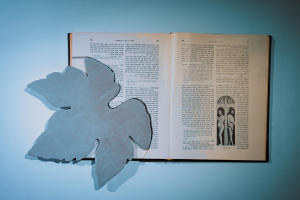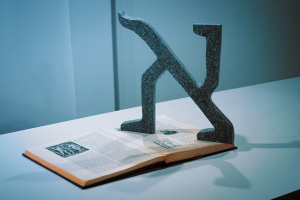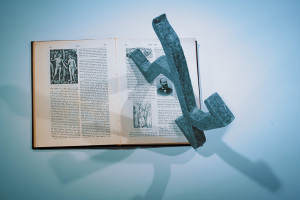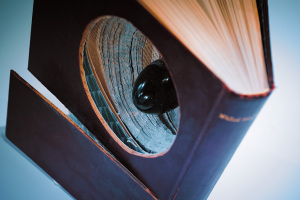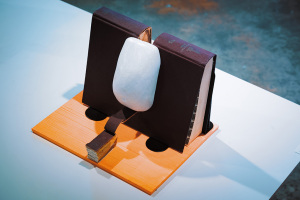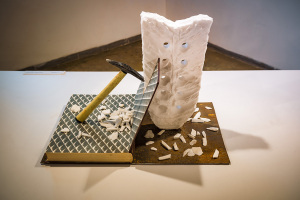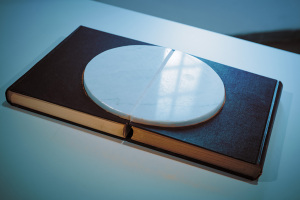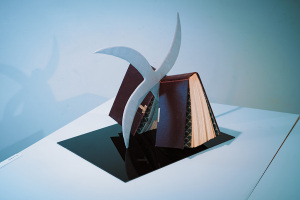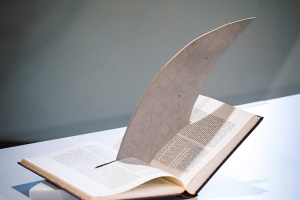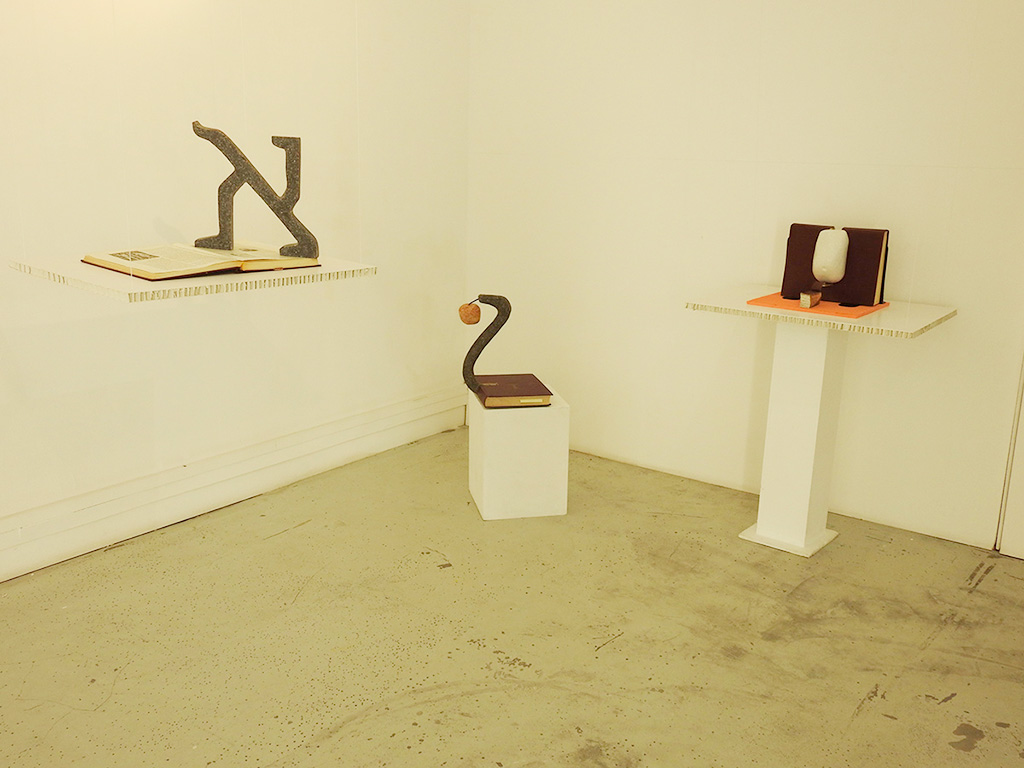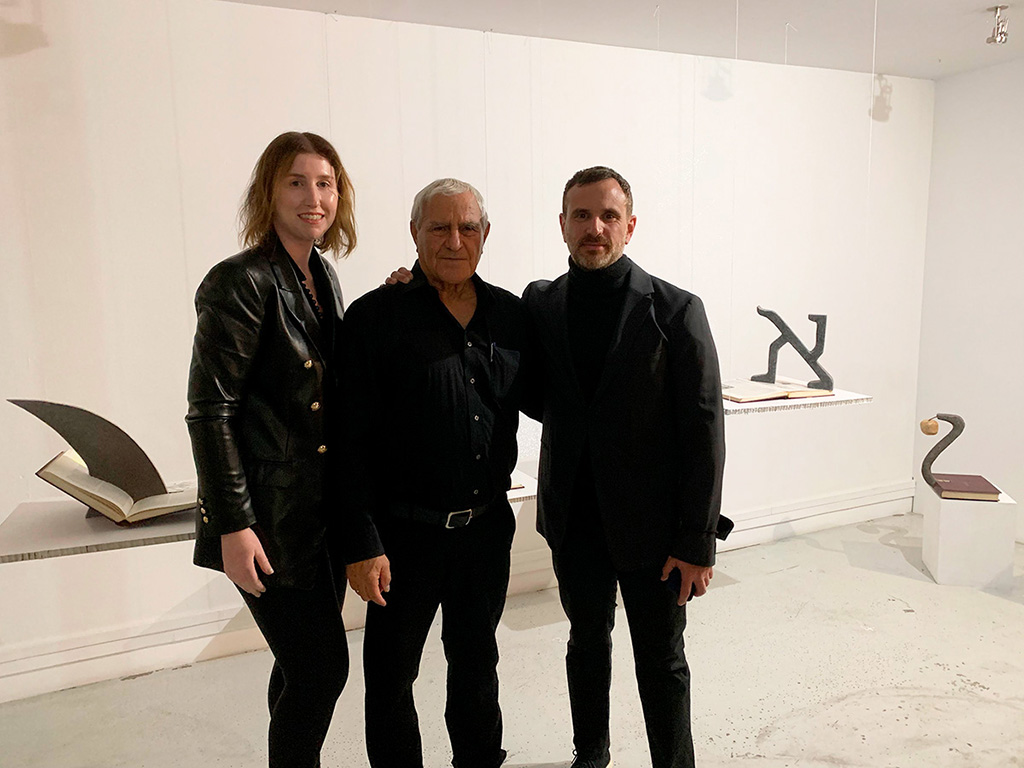FROM NATURE TO MYTH by Margalit Berriet
«Toute vie véritable est rencontre…. Au commencement est la relation.»
(“All true life is encounter…. In the beginning is the relationship.”)
Martin Buber
The patrimonies of humanity include people of both known and forgotten civilizations. Their individual and collective myths and testimonials are the results of their processes of observation, their perceptions and comprehensions, and their abilities of preservation.
The series of allegorical stone sculptures by Avi Sperber entitled From Eternal Life To Life And Death is an attempt to create metaphors for the journey of humanity from nature to culture. The sculptures translate the conceptual content of the third chapter of the Book of Genesis—the story of Adam and Eve—according to Sperber’s personal understanding and imaginative expression, nourished by his examination of intellectual questions. His use of stones in these sculpted pieces is an allegory of the first attempts of human beings to preserve their own voices, leading to the birth of communication, language, and writing. Stones are associated with celestial, eternal time. They often symbolize the passage from this life to the next. By linking stones to books, Sperber invites us to link the present to the past, and questions the process of writing and of knowledge.
If we attempt to question the essence of humanity and of nature, we recognize that legends and traditions are composed of individual and collective memories, producing suppositions, ideas, tools, and technologies—the means to communicate theories, beliefs, and discoveries.
From its embryonic state to its adult persona, a constant interaction exists between a human being and its environment. These are the paths for creating cultures and societies. From drawings and symbols, human beings gave birth to the grammar of the humanities, and produced the means to leave traces, accumulate memories, open debates, and communicate their understanding of nature.
The myth of the Garden of Eden tells of the beginning of all things. The Garden is a metaphor for longing, of yearning for the ideal life, and thus for the hope of a universal community for all beings, with respect and equality for all. In the words of Walter Benjamin, “Paradise is the origin of man, but also a utopian vision of his future redemption.”[1]
The third chapter of the Book of Genesis attempts to describe the birth of civilized man, of the urge to comprehend the world and to know. It is an allegory of the mechanisms of human understanding, leading humanity into its never-ending process of sensing, interrogating, and creating.
Adam and Eve are, therefore, metaphors for the process of creating humanity’s knowledge and morals—an etiological account, also, of natural phenomena, giving birth to what become a “homeland,” of community, and of the use of the arts to create knowledge.
Myths are attempts to explain the birth of all cultures, and of their diversities. “The history of art and that of man are in-dissociable; Art begins with man or even, perhaps, with his direct predecessor the Australopithecus. From the beginning, man asserts himself as an artist, because he shares his first instincts with other animals, perhaps with some great apes, because he immediately collects the “works of art” of nature, because he immediately creates shapes, he produces traces and very early he invents the first ornaments.”[2]
Once Adam and Eve could see, hear, sense, and think, they could question and generate ideas, hypotheses, and ethics, and could also create ornament. Cultures are composed of things, habits, traditions, roles, identities, while morality, differing between “evil” and “virtuous,” became inseparable from aesthetics. All myths are metaphors, demonstrating why, how, when, and where cultures have been formed, and how they shape civilizations.
Creativity, then, became an asset in the service of the never-ending development of humanity—forming, through time, philosophies, laws, religions and, therefore, new messages. Intellectual and spiritual expressions are evidence of attempts to understand the forces of nature and of life, from the standpoint, also, of good and evil.
According to Jean François Dortier, “… the first traces of artistic creation appear with the Bifaces (hand-axe). Their creation supposes not only to sense the beautiful, but to produce it as a technical tool.”[3]
Although the sense of the sacred and the creation of myth seem to be a skill of human beings, in its founding of societies and the creation of guidelines for their survival, yet we also find, in the social structures of all beings, the organizing of group behaviour, as well as that of individuals.
Nature is, in itself, a concept, with a strong cultural content. For example, according to Augustin Berque, “… nature is necessarily translated into terms specific to a culture; it is integrated into the world that man is capable of conceiving, perceiving and developing. In this case, nature does not challenge itself without or against man but by man.”[4]
Cultures are rooted in a time and place. They define how people relate to nature and their physical environment, to the earth and to the cosmos, and they express our attitudes and beliefs about other forms of life, both animal and plant:
“Cultural understandings of the environment not only give rise to sustainable management practices, but also to knowledge of species requirements, ecosystem dynamics, sustainable harvesting and ecological interactions. This culturally engrained knowledge can enable people to live within the constraints of their environment in the long-term.”[5]
At a fundamental level, biological and cultural diversities are closely interdependent. They have developed over time through mutual adaptation between humans and the environment. Therefore, rather than existing in separate and parallel realms, they interact with and affect one another in complex ways, in a sort of co-evolutionary process.[6]
In Avi Sperber sculptural work we find references to this interdependent mutual adaptation between humans and the environment. Although, Nature is everything that is, and the world is independent of one’s will, both are interacting with each other, and affect one another in complex ways, in a sort of co-evolutionary process, and nature is the origin of all creations. Case: The letter Aleph – A- א is derived from the Semitic word for “ox” derives from a Proto-Sinaitic glyph that have been based on an Egyptian hieroglyph drawing of the Ox. the Ox abundant its semen and fertilizes the earth, it symbolises the force creator, and in Babylon it become the Ox of gold, the myth practiced by the cult El. [7]
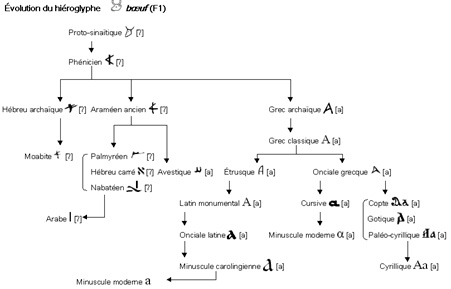
To conclude, nature and culture are often seen as opposite ideas—what belongs to nature cannot be the result of human intervention and, on the other hand, cultural development is achieved against nature. However, this is by far not the only take on the relationship between nature and culture.[8]
- Quoted in Alexandre Guilherme, Ilan Gur-Ze’ev and Education: Pedagogies of Transformation and Peace. Routledge, 2021.
- Michel Lorblanchet, Les origines de la culture, les origines de l’art, Editions le Pommier, 2006, p. 3.
- Marie Soressi & Harold L. Dobble, eds., Multiple Approaches to the Study of Bifacial Technologies, https://hal.archives-ouvertes.fr/file/index/docid/573698/filename/Soressi_Dibble2003_eds_BifaceBook.pdf
- Augustin Berque, Médiance. De milieux en paysages, 1990. Revised by Belin Editeur, 2000.
- https://www.resurgence.org/magazine/article2629-nature-and-culture.html
- From UNESCO, Linking Biological And Cultural Diversity—Outcomes of the 2010 International Conference on Biological and Cultural Diversity, Montreal, “2010 Declaration on Bio-cultural Diversity.”
- DICTIONNAIRE DES SYMBOLES. Mythes, Rêves, Coutumes, Gestes, Formes, Figures, Couleurs, Nombres, by Jean and Gheerbrant, Alain Chevalier, 1982, Éditions Robert Laffont/ JUPITER/ the Taureau p 929
- Andrea Borghini,ed., Indigenous Intelligence: Diverse Solutions for the 21st Century, Issue 250, September/October 2008.
FURTHER REFERENCES
- Ameisen, Jean Claude. «La musique des mots,» France Inter, September 4, 2021: https://www.franceinter.fr/emissions/sur-les-epaules-de-darwin/
- Eiselein, Gregory, Anna Goins, and Naomi J. Wood, eds. Studying the Bible: The Tanakh and Early Christian Writings, New Prairie Press, 2019.
- Goodman, Alan H., Deborah Heat, and Susan M. Lindee, eds. Genetic Nature/Culture: Anthropology and Science Beyond the Two-Culture Divide, University of California Press, 2003.
- Giblette, Rodney James. The Body of Nature and Culture, Palgrave Macmillan, 2008.
- Kraus, Marian, Symbolism And Ancient Wisdom In Stones: https://www.mariankrausphotography.com/2012/02/02/ancient-wisdom-in-rocks-and-stones/
- Lévi-Strauss, Claude. Les structures élémentaires de la parenté, 1949.
- Ressources de géographie pour les enseignants, «Nature et culture»: http://geoconfluences.ens-lyon.fr/glossaire/nature-et-culture
- Verdure, Christophe. La culture, refl et d’un monde polymorphe, https://www.futura-sciences.com/planete/voyage/culture/, published May 19, 2003, revised November 11, 2015.
- Watson, Peter. The Great Divide: Nature and Human Nature in the Old World and the New, Harper, 2012.
From Eternal Life to Life and Death
Avi Sperber has created a series of stone sculptures connected to books, allegorical works that act as metaphors for the story of sin and punishment in the Book of Genesis.
The sculptures give three-dimensional expression to the duality of the artist’s feelings. On the one hand, he uses them to translate conceptual content in light of his artistic understanding, nourished by an analysis of the human mind, and on the other hand, he uses them to create empathetic, immediate, emotional, and even romantic expressions of his feelings.
The use in these works of stone – an eternal substance, linking the past and the future, together with organic materials that “lock horns” with the latest industrial materials – creates a dramatic and extraordinary relationship in the eyes of the viewer. There is tension between the books, which serve as a Jewish symbol (“people of the Book”), suitable for a wandering and mobile people, and stone, which is tied to a specific place and landscape, evidence of a mythical and historical link to a defined site.
Avi Sperber creates a renewed expression of the story of the third chapter in the Book of Genesis, the chapter in which the first couple, Adam and Eve, make an appearance and which describes the first sin and the expulsion from the Garden of Eden. This is the most human, the most fascinating and the most allegorical chapter to be found in the whole of Genesis. The story of the woman’s temptation by the serpent, and the Creator’s curse of Adam and his wife, is still the inspiration for endless works of art.
In my opinion, this chapter defines a number of mythical and immortal facts of life. The first is the possibility of man distinguishing between good and evil. The second is the subject of giving birth in sorrow and man’s control over women. The third is the curse of the soil for man, and his return to it at the end of his life. The fourth is the whirling sword which guards the tree of life from man. All these are incomparable visual symbols for representation in three-dimensional sculpture.
Avi Sperber created this series in the craziest and most unfamiliar period of this millennium, during the covid epidemic, which has cut us off from the flow of normal life for a year. This may be a small exhibition, but it has profound and fateful significance, and makes us stop and think about our lives and our future.
Doron Polack/ Exhibition Curator
(Excerpt of the video)
PERFORMANCE
Initium
Creation for electronic device and dancer
This sound and performance piece is a double beginning: a collaboration
between the composer and visual artist Daniel Cabanzo and the performer
and visual artist Jennifer Gold, and the starting point for the creation of a
series of sound pieces that will compose Daniel Cabanzo’s next album.
The artists propose a dialogue in sound and movement around the work of
Avi Sperber.
Daniel Cabanzo x Jennifer Gold
DANIEL CABANZO (Colombia, born in 1979) is a multidisciplinary artist
who is interested in different forms of art expression. He studied music
at the University of Valle in Cali, Colombia, and composition in France
since 2006. He holds a master’s degree in Music applied to visual arts
from the University of Lyon 2 and a master’s degree in Acousmatics and
sound arts from the Ina-GRM and the University of Paris-Est.
In 2013, he studied at the HEM of Geneva, a school that influenced him
towards new musical technologies. He received the DNSPM diploma in
Composition from the PSPBB in 2014. He is laureate of the Cergy-Pontoise
composition prize and of the Roux et Tronchet prize of the Académie
des Beaux-Arts, also laureate of a SACEM grant to study in the Cursus
d’Informatique Musicale at IRCAM in 2014.
He participated in the Manifeste academy organised by IRCAM as part
of the In Vivo Electro 2015 workshop, and collaborated with Le Fresnoy
– Studio National des arts contemporains for the Panorama 2016 edition.
Winner of the Ibermusicas 2018 prize with the DME institution in Portugal,
the same year he is resident at the Villecroze Academy. In 2019 his
piece for piano and electronic device «Electronic introspections 1» was
performed at Radio France for the programme Alla Breve. In 2021 he is
doing a residency at the Royaumont Foundation with the XAMP microtonal
accordion project Pulse and the ARCO residency with the TANA quartet
at GMEM in Marseille. He is currently doing his PhD in musicology at the
University of Paris-Sorbonne and IRCAM. He has been played by several
ensembles in France and in other countries.
The evening of the opening
Friday 8 October at 8pm
After training as a dancer and actress, JENNIFER GOLD decided studied
philosophy. In 2015, she joined a theatre company that evolves within the
Parisian underground scene. In 2017, together with two other artists, she
created an independent production called «Sans Raison» which specialises
in fiction, experimental film and performance. From Kant to Genet, through
expressionist dance, butoh and cabaret, Jennifer practices the alliance, even
the symbiosis, of concepts supposedly in contradiction
Chapter 3
Man, like every living thing, will die. Death is unavoidable. Man, like an animal that is terrified by every danger and especially by one that threatens its life, tries to escape. But man is an intelligent animal. He thinks, understands, investigates, is not satisfied by merely knowing about the existence of death and never stops looking for ways to overcome it, in an attempt to escape it and fulfill his yearning for eternal life.
The story of the creation of the world and man runs through the myths and legends of other peoples in different forms. In the monotheistic religions, following the creation of the world, the beginning of human civilization is found in the Garden of Eden, where man was created by God, the eternal force that controls everything.
The Garden of Eden is the place of the beginning of all things and the eternal source of the patterns of life. It is the object of longing, yearning, and the hope of reward manifested in eternal life. In the words of Walter Benjamin: “Paradise is the origin of man, but also a utopian vision of his future redemption.”
The third chapter of the Book of Genesis describes the birth of civilized man, the man with a tireless urge to know. The story is an allegorical fusion of characters and processes that represent various components of human life, which have been interpreted over the generations by many people in different ways and led to the beliefs that affect our lives to this day.
When their eyes were opened, Adam and Eve experienced shame for the first time. They understood that they were similar yet different; their organs defined their identity – man and woman. By covering their private parts with fig leaves they expressed their recognition of their differences and their desire to maintain privacy and intimacy. The determination of gender becomes more powerful as the story proceeds, particularly in the punishments imposed on them by God: the woman will bear children in sorrow and the man will live by the sweat of his brow and will rule over the woman. This patriarchal definition of the relationship between man and woman has determined relations between the sexes for many generations.
Adam and Eve discovered fear, too, when their eyes were opened, and they hid from God when they heard his voice in the Garden. This fear also explains man’s relationship with God. God asks, “Where art thou?” although he knows where Adam is. “Big Brother” represents the relationship between ruler and ruled, between the one who transgresses and the one who punishes.
The Garden of Eden was nature, the home of the animals. Man, too, was part of nature. He ate, drank, did not understand and did not know. The serpent in the story is a wild creature of the field – it represents nature, but it is craftier than any of the other animals, and was therefore chosen as mediator between nature and civilization. It tempts Eve, and through her it transfers knowledge, wisdom and civilization, removing him from nature. Some say that language was born at the moment when Adam gave warning of the serpent’s presence. Later, people developed written communication, first in the form of shapes carved in stone, and later with letters and fonts. The serpent brought language and culture to man, petroglyphs evolved into books and, as human society spread throughout the world, human culture took on many different shades.
There is an interpretation that the serpent tempted Eve because there was love between them (in parentheses, Aphrodite also offered an apple as a promise of love). Other interpretations, mainly Christian ones, are fed by the idea of celibacy and the patriarchal approach. Eve is presented as the one who tempted Adam and thus caused him to commit the sin of lust. And for that reason, all her daughters, that is, all women, are guilty of the sin.
The Tree of the Knowledge of Good and Evil is called “the tree upon which death depends.” It is the origin of the start of human civilization and human fate. Eating its fruit brought understanding, consciousness and knowledge, but also brought the sentence of death.
Eating the fruit of the Tree of Knowledge set everything in motion. Man, who was part of nature, had his eyes opened to understand the world around him. He began to see the questions raised by knowledge, moral questions of good and evil, of what is forbidden and what is permitted, questions about the relationship between men and women, questions about the relationship between the ruler and the ruled, and the relationship between man and God. Man learned about shame, guilt and fear, about commands and prohibitions, about sins and punishments, and the difference between the eternal and the ephemeral.
The third chapter ends with man’s expulsion from the Garden of Eden, that is, from nature to the space of knowledge and culture.
Adam, at the moment when the gates of the Garden of Eden closed behind him, suddenly faced an unknown world. He knew he had to go on, to move forward, but to where? In fact, this is the beginning of the odyssey towards an unknown, unclear civilization, a never-ending journey. Today, as throughout history, we stand in that same spot, facing social, technological and economic developments leading to an uncharted civilization.
Ever since man’s expulsion from the Garden, he has been troubled by that question of finality – death. In his attempt to escape his fate, he has developed various beliefs in the resurrection of the dead and reincarnation. In Judaism there is the expectation and belief that the Messiah will come, bringing with him the resurrection of the dead. The ancient Egyptians believed that the dead pass over to the world of the dead where they continue a kind of life and, when the time comes, will return to life on earth. In Kabbalah there is a belief that man is reborn and rises through the spheres on the basis of his good deeds in life, with the goal of reaching God and uniting with him. The Indians, the Druze and many others all believe in reincarnation.
All these are man’s attempts to return to the Garden of Eden, but this object of yearning poses a dilemma for man, between eternal life – which means a desire to return to the past, to nature, to live as one of the animals – and the lust for strength, to develop abilities and knowledge while looking to the future – to become like God.
The exhibition presents the text of the third chapter by means of symbols that represent the words and actions in it, thus presenting a picture of the continuity of events in the creation of human civilization.
The materials used in the sculptures, stone and book (ready-made), represent the same idea. Stone is a natural material, and the book is language, the material of civilization. The books are volumes of the Hebrew Encyclopedia, a comprehensive Hebrew-language encyclopedia, which was published with the establishment of the State of Israel in 1948. Today, with the development of technology and the enormous range of information on the internet, there is hardly any use for it, and its volumes are sent for recycling, so it represents the ephemeral object – man.
Avi Sperber





